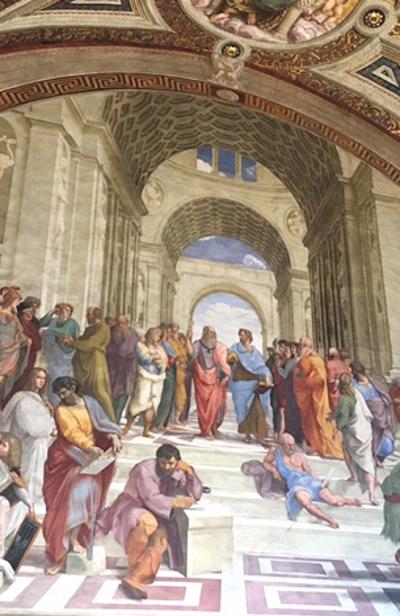My Rome
The School of Athens is one of the most famous frescoes by the Italian Renaissance artist Raphael. It was painted between 1509 and 1511 as a part of Raphael's commission to decorate the rooms now known as the Stanze di Raffaello, in the Apostolic Palace in the Vatican, which is now a part of the Vatican Museum. The Stanza della Segnatura was the first of the rooms to be decorated, and The School of Athens, representing Philosophy, was probably the second painting to be finished there. The picture has long been seen as "Raphael's masterpiece and the perfect embodiment of the classical spirit of the Renaissance". People have suggested that nearly every great ancient Greek philosopher can be found in the painting, but distinguishing between each philosopher is difficult. But few such interpretations are unanimously accepted among scholars, one of the popular ideas are the gestures of Plato and Aristotle pointing to the heavens, and down to earth. It is not certain how much the young Raphael knew of ancient philosophy, what guidance he might have had from people such as Bramante, or whether a detailed program was dictated by his sponsor, Pope Julius II. Nevertheless, the fresco has even recently been interpreted as an exhortation to philosophy and, in a deeper way, as a visual representation of the role of Love in elevating people toward upper knowledge. Painters like Raphael ultimately shaped the minds of the Romans during the Renaissance and continues to do as such today.
School of Athens by Raphael
January 17, 2017
The School of Athens is one of the most famous frescoes by the Italian Renaissance artist Raphael. It was painted between 1509 and 1511 as a part of Raphael's commission to decorate the rooms now known as the Stanze di Raffaello, in the Apostolic Palace in the Vatican, which is now a part of the Vatican Museum. The Stanza della Segnatura was the first of the rooms to be decorated, and The School of Athens, representing Philosophy, was probably the second painting to be finished there. The picture has long been seen as "Raphael's masterpiece and the perfect embodiment of the classical spirit of the Renaissance". People have suggested that nearly every great ancient Greek philosopher can be found in the painting, but distinguishing between each philosopher is difficult. But few such interpretations are unanimously accepted among scholars, one of the popular ideas are the gestures of Plato and Aristotle pointing to the heavens, and down to earth. It is not certain how much the young Raphael knew of ancient philosophy, what guidance he might have had from people such as Bramante, or whether a detailed program was dictated by his sponsor, Pope Julius II. Nevertheless, the fresco has even recently been interpreted as an exhortation to philosophy and, in a deeper way, as a visual representation of the role of Love in elevating people toward upper knowledge. Painters like Raphael ultimately shaped the minds of the Romans during the Renaissance and continues to do as such today.

Share your travel adventures like this!
Create your own travel blog in one step
Share with friends and family to follow your journey
Easy set up, no technical knowledge needed and unlimited storage!